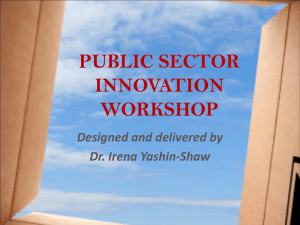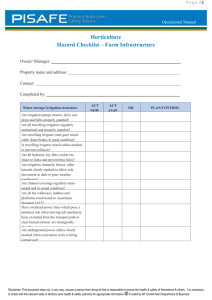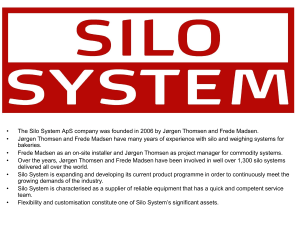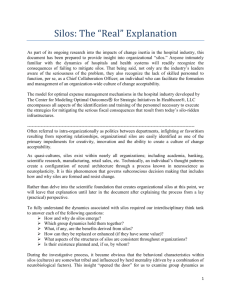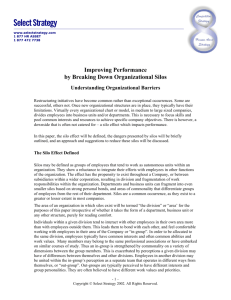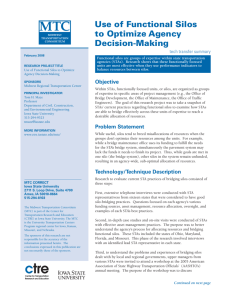Bridging – Not Busting - Silos
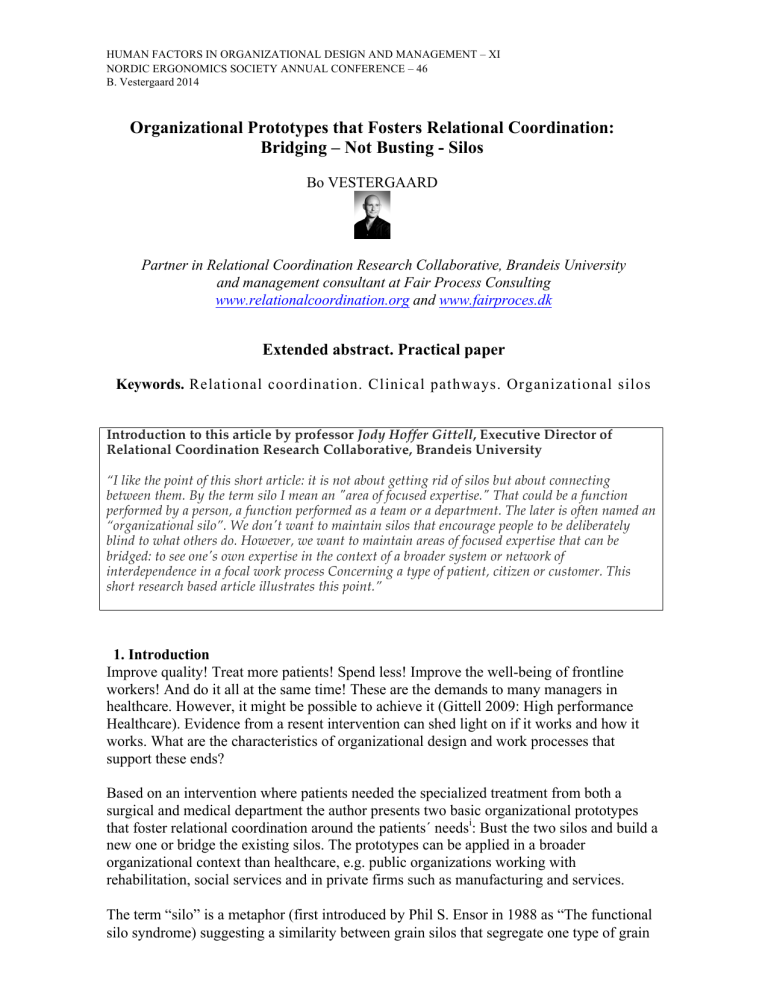
HUMAN FACTORS IN ORGANIZATIONAL DESIGN AND MANAGEMENT – XI
NORDIC ERGONOMICS SOCIETY ANNUAL CONFERENCE – 46
B. Vestergaard 2014
Organizational Prototypes that Fosters Relational Coordination:
Bridging – Not Busting - Silos
Bo VESTERGAARD
Partner in Relational Coordination Research Collaborative, Brandeis University and management consultant at Fair Process Consulting www.relationalcoordination.org
and www.fairproces.dk
Extended abstract. Practical paper
Keywords. Relational coordination. Clinical pathways. Organizational silos
Introduction to this article by professor Jody Hoffer Gittell , Executive Director of
Relational Coordination Research Collaborative, Brandeis University
“I like the point of this short article: it is not about getting rid of silos but about connecting between them. By the term silo I mean an "area of focused expertise." That could be a function performed by a person, a function performed as a team or a department. The later is often named an
“organizational silo”. We don't want to maintain silos that encourage people to be deliberately blind to what others do. However, we want to maintain areas of focused expertise that can be bridged: to see one's own expertise in the context of a broader system or network of interdependence in a focal work process Concerning a type of patient, citizen or customer. This short research based article illustrates this point.”
1.
Introduction
Improve quality! Treat more patients! Spend less! Improve the well-being of frontline workers! And do it all at the same time! These are the demands to many managers in healthcare. However, it might be possible to achieve it (Gittell 2009: High performance
Healthcare). Evidence from a resent intervention can shed light on if it works and how it works. What are the characteristics of organizational design and work processes that support these ends?
Based on an intervention where patients needed the specialized treatment from both a surgical and medical department the author presents two basic organizational prototypes that foster relational coordination around the patients´ needs i : Bust the two silos and build a new one or bridge the existing silos. The prototypes can be applied in a broader organizational context than healthcare, e.g. public organizations working with rehabilitation, social services and in private firms such as manufacturing and services.
The term “silo” is a metaphor (first introduced by Phil S. Ensor in 1988 as “The functional silo syndrome) suggesting a similarity between grain silos that segregate one type of grain from another and segregated departments in an organization. The connotations are often negative, meaning that the entire organization’s silos are not united in a shared goal but
HUMAN FACTORS IN ORGANIZATIONAL DESIGN AND MANAGEMENT – XI
NORDIC ERGONOMICS SOCIETY ANNUAL CONFERENCE - 46 engaged in unproductive turf wars and sub optimizing (optimizing work processes within a silo without regard to the interdependence and shared goals with other silos: This leads to negative effects on the quality of outcome for the customer/patient and inefficient use of resources for the organization). But a silo has clear strengths. In an organization each silo allows for professional specialization around a specific type of patient (“grain”). However, in practice some patients are in need of specialized treatment from different departments
(silos), e.g surgical patients with medical complications. This is where the silo structure runs into trouble.
2. Why organizational silos are great and when to bridge them or bust and rebuild
An organization with a high degree of relational coordination is comprised of work processes around groups of citizens´/patients need. When the silo´s work processes are well structured around the patients needs, the patients will experience that they get the right things done to them when they are ready for it, not just when the staff is ready for it.
When a group of patients needs cut across not only differently specialized staff (within a department) but also departments (across functional silos), there is basically two ways to organize in order to foster relational coordination. One is to create a new department comprised of some staff from the original departments. This new department is established with a budget, management, staff and a core task of creating and conducting a well structured and relational coordinated work process for a specific group or groups of patients/citizens. The other way is to bridge the two or three organizational silos that are involved in the treatment of the patient. Bridging means creating a work process across the silos (departments) that allows/makes it practically possible for staff to ensure that patients get the right things done to them when they are ready for it, not just when the staff is ready for it. Compared to busting and building, bridging is quick, easy and low cost. Below I present an example of bridging silos.
2.
Results: Bridging two silos – an example from practice
This case is about orthopedical patients (e.g. hip or knee replacement) with medical problems (like diabetes or changes in their condition after surgery that relates to their metabolic system, liver, kidney ect.) The patients are in the hospital for surgery. However, after operation many patients get complications, that requires the expertise of a medial - not a surgical - specialized doctor.
What did the work process look like before bridging the silos?
When a patient gets medical complications the surgeon summons a medical specialist. In practice in may take from 24 hours to 3 days before the specialist arrives and can stabilize the patient and improve their condition. Also, as the patient is the responsibility of the orthopedical department the medical doctor needs to have recommendations for treatment approved by the orthopedical department. In practice it is approved but it causes a delay in treatment of the patient. The work process (summoning of a medical specialist) is ad hoc, meaning that the summoning occurs when the situation arises. However, it is predictable that every day there are patients getting medical problems. Therefore it might be a better solution to bridge the silos by creating a work process routine that allows medical specialists to attend to patients on a daily basis.
What did the work process look like after bridging the silos?
Every morning (1/2 day) a senior doctor from the endocrinology department (medical doctor) is part the conference held by the orthopedical department. Here they spot patients
HUMAN FACTORS IN ORGANIZATIONAL DESIGN AND MANAGEMENT – XI
NORDIC ERGONOMICS SOCIETY ANNUAL CONFERENCE - 46 that may need to be visited in a patient round with a medical doctor and an orthopedical nurse. The medical doctors are allowed to start medical treatment without having to get an approval from the orthopedical department every time. 12 different senior medical doctors are in the loop. Only senior doctor are in the turnus because it allows for timely decisions and actions on the spot. In RC terminology the work process is comprised of crossfunctional huddles (conference and patient rounds) that allows for timely, accurate problem solving communication around a shared goal.
Results
A 63 percentage drop in medical calls, meaning that the senior doctors from endocrinology can stabilize and improve the conditions of almost 2/3 of the patients that has medical complications. The remaining 1/3 need other specialized medical attention and the endocrinologists are far more competent in deciding which specialized doctors are needed when. It can be speculated that this work process creates improve quality for the patient and less overall costs for the hospital as patients are getting the right treatment quicker. The staff involved, report that they prefer the new work process to the old one and are convinced that it provides better quality for the patient and makes their work effort more meaningful.
i From 2012-2013 11 project Relational Coordination was jointly launched at Two Danish hospitals. The project consisted of 11 minor projects. Each minor project set out to improve quality, efficiency and worker wellbeing by altering work processes and improving clinical pathways. The level of relational coordination, worker well-being, efficiency and clinical quality was measured before and after the intervention. Interviews was conducted with manages and frontline personnel in order to find out if there was indeed a sustainable change in work processes and how it was connected to changes in the variables mentioned above. 10 out of 11 projects was defined as an success. Research was conducted by senior researcher Kasper Edwards, DTU. The author acted as a management and organizational consultant for the projects. Relational coordination tools was used at work camps to
redesign work process and fair process was used to design and lead the change effort.
